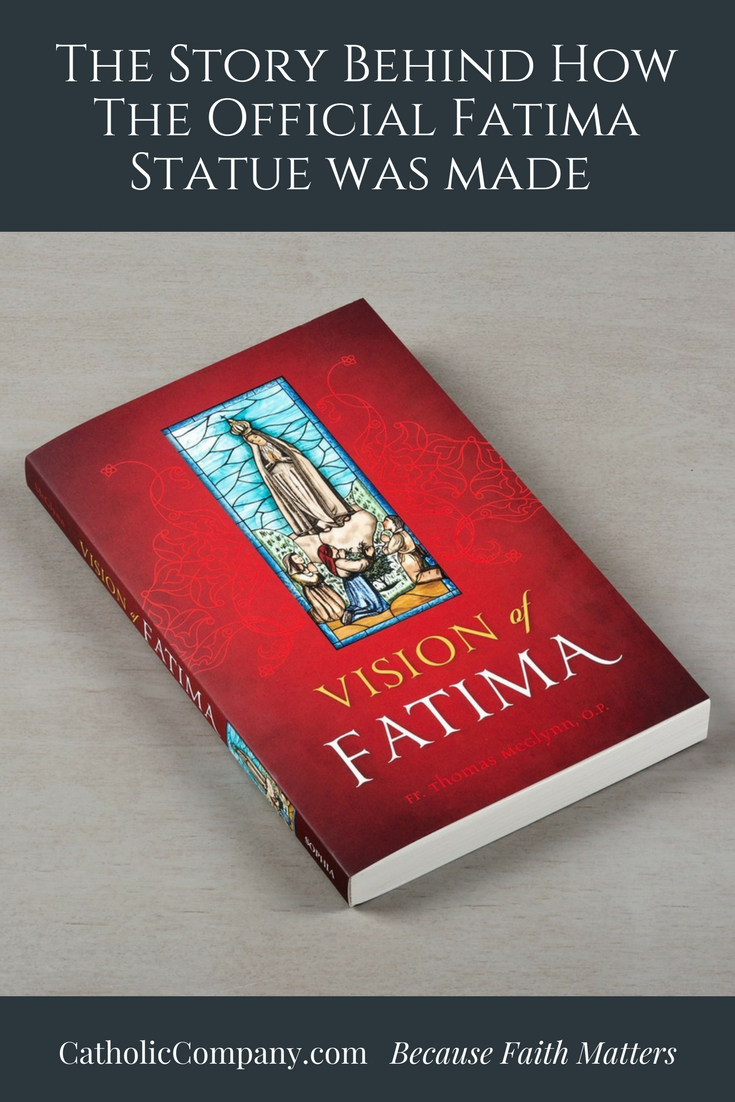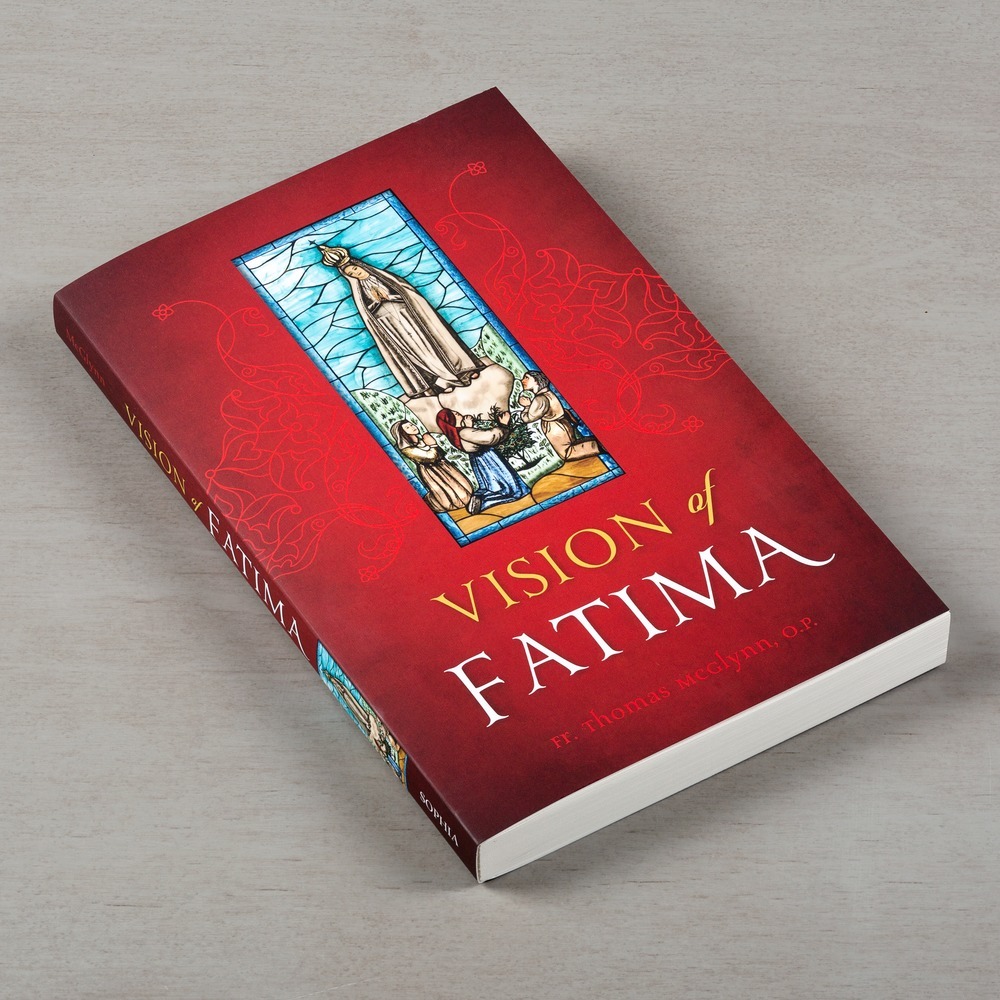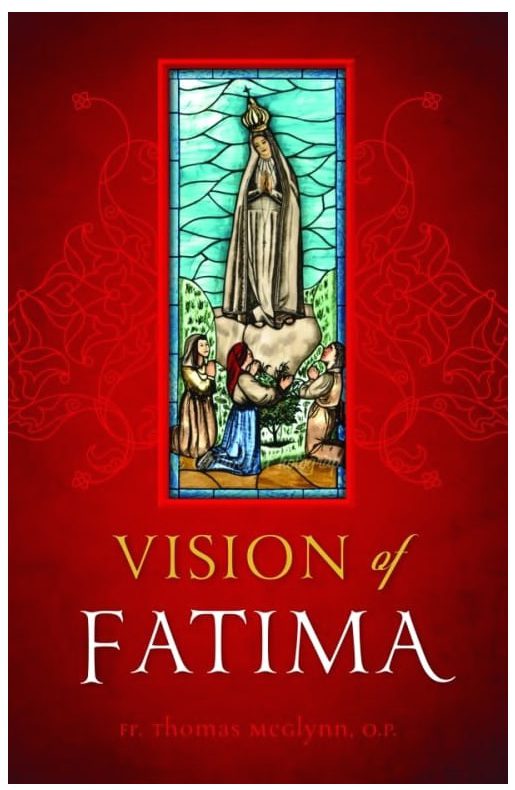The Story Behind the Making of the Official Fatima Statue
Apr 24, 2017 by Gretchen Filz
The below excerpt is taken from the book Vision of Fatima by Fr. Tom McGlynn, O.P., the sculptor who crafted the Our Lady of Fatima statue according to the instructions of Sr. Lucia Santos, the last surviving of the three Fatima seers. It regards the friar's first meeting with Sr. Lucia.
Irmã Dores and the Apparition
From now on I am going to call Lucy “Irmã Dores.” It is the name by which she is known in her community. Irmã (as I was later to learn) is Portuguese for “sister.” Dores is derived from the surname of her former pseudonym, Maria das Dores, which was given to her by the bishop when she was placed in the orphanage as a child. Used for a first name, its only equivalent in English is Dolores, since “sorrows” — the meaning of the word as a common noun — is not a name in English.
Strangely, however, Irmã Dores, although never addressed as Irmã Maria Lucia, usually signs her name “Irmã Maria Lucia de Jesus”; when she signs her full name, it is “Irmã Maria Lucia de Jesus Rosa Santos.” Still, at the Colégio do Sardão, she is always called just Irmã Dores.
Before I visited Sardão, I always thought of her as Lucy, the girl to whom the Blessed Virgin appeared at Fatima; since I have known her, I have always thought of her as Irmã Dores, the sister who lives in order to make the message of Our Lady of Fatima known to the world.
Father Gardiner first conveyed the greetings sent by Maria and Teresa. Irmã Dores thanked him and inquired after her sisters. It was now my turn to speak. I started by telling her that the following day would be the centenary of the consecration of the United States to the Immaculate Conception and asking her to pray for my country. As she later did at such requests, she nodded humbly as if embarrassed and faintly said, “Yes.”
Her expression was not easily identified. Her eyes were most attentive and always fixed upon the person who was speaking. There seemed to be both passive and active qualities in her attitude. She humbly attended on the completion of any question yet keenly studied the person and words of the questioner. Agility and strength of mind were reflected in her mobile, expressive mouth and large chin. She sat relaxed but leaning a little forward. Her hands were usually folded in her lap, but sometimes she extended the fingers, pressing the palms on her knees in a natural gesture of relaxation from the tedious examination. Her voice, thin and high-pitched, fell in rather monotonous cadences — a characteristic which I have observed of many Portuguese, in contrast with the more varied tonal articulation of other Latin peoples. On provocation she laughed with spontaneity and brevity, consistent with her fine sense of humor and lifelong characteristic of reserve.
The explanation of my visit was briefly made. I was a sculptor. I had been commissioned to make a statue of Our Lady of Fatima, and I wanted the representation to be accurate. I wished to obtain her description of the vision. To facilitate her description I had brought along a small model for her to criticize.
Irmã Dores had already seen the statue across the room. She had shown no reaction whatever. I supposed that this was due to her reverent attentiveness to anyone speaking and was not a sign of disapproval.
Very little light was coming into the room from the torrents outside. When the moment came for her to inspect the statue we all moved to the window. My hopes were sustained by remembering the many comments of approval that the statue had received from my family and friends. I felt that its artistic validity had been established by the judgment of my former teacher, Mr. Carl Milles: “The best statue you have ever made.” Now I would have the most important opinion of all. “If she approves . . .” I would know soon.
I held my work at the most favorable height for her to study it. A very long second followed in which all of us waited for her reaction. Wrinkles formed on her brow (and in my soul).
“Não dá posicão,” she said. That was the first sentence of Portuguese I learned and one I shall never forget: “It’s not the right position.”
“The right hand should be raised and the left lower down,” she continued. I knew she was speaking of the June apparition and hastened to explain that in the gesture portrayed I was not intending to be descriptive but symbolic. I was indicating in the position of the hands the devotional message of Fatima, namely, the Immaculate Heart and the Rosary.
She smiled at my apologetic, unable to gather the interest I had in symbolism; nothing could substitute for the reality with her, it was obvious. She simply repeated her first comment, “Não dá posicão.”
During this discussion, Irmã Dores noticed the strap that had been around the box lying on the floor, where, in my haste and distraction, I had left it. Without interrupting the conversation, she picked it up, folded it neatly, and put it on the box.
“The garments in the statue are too smooth,” she said, after we were all seated again and the statue was resting on the little marble-topped table. The fascination of speaking with someone who had seen and spoken with our Lady contended with the disappointment of her not approving the work sufficiently to keep me interested in further criticism.
Again an apologetic: “I knew from published descriptions that the vision was very brilliant. Now, it is impossible to express light in sculpture otherwise than by reflecting light from simple surfaces. That is why I made the garments so smooth.”
“But the light was in waves and gave the impression of a garment with folds” (literally an undulated garment), she said. “She was surrounded by light and she was in the middle of light,” she went on, confirming the truth of my previous observation about brilliance. Then she added: “Her feet rested on the azinheira.”
This was a shock. Was there no cloud? Every account and every image had indicated that there was. The problem of designing the cloud had been especially vexing during the modeling of this statue — how to make something that would suggest vapor and still be integrated in a solid composition. I had thought, finally, that I had solved the problem quite well in the little carpet-like cloud that had emerged beneath the feet of the figure. Did Irmã Dores now mean that there was no cloud? I asked her.
“The people spoke of a cloud, but I saw none. Our Lady’s feet rested lightly on the tops of the leaves.” I told her I was disappointed because I thought the cloud a very pretty form.
Next, an omission was observed: “She always had a star on her tunic.” I had thought that was one of the mistakes in the conventional image. Well, that would easily be remedied. But then she added another detail, one I had not heard of: “She always had a cord with a little ball of light,” she said, indicating an imaginary pendant around the neck falling to about the waistline. It was this detail that was mistaken for a cord and tassel after the first investigations in 1917.
Irmã Dores seldom referred to the Blessed Virgin as nossa Senhora, or “our Lady,” but generally used just the personal pronoun ela, or “she.” But, as Father Gardiner pointed out later, she pronounced ela with an inflection of such reverence that it became quite restricted, as though, used in that manner, it could apply to no one but our Lady.
Further points of information about the dress of Our Lady of Fatima were brought out in Irmã Dores’s answers to a series of questions: there were only two garments visible — a simple tunic and a long veil, or mantle; the tunic had no collar and no cuffs; there was no cincture or sash around the waist, although the tunic was drawn in at the waist. When I asked Irmã Dores about the width of the sleeves of the tunic, she tugged lightly at a sleeve of my coat and said they seemed to be about that wide.
To fill out the form inside the mantle beside the neck I had shown the hair of our Lady. Although I had no justification in any description, neither did I know of any objection. The device had two advantages: it made the face appear more youthful, and it eliminated what I considered an objectionable shadow. I inquired what Irmã Dores thought of it.
“I never saw the hair.” That settled that!
[[8850,4082]]
The statue again reminded her of the June apparition. “She appeared as the Immaculate Heart in June only,” she said; then getting her Rosary out of a pocket of her habit, she draped it over the palm of her right hand and joined her hands in the attitude of prayer, continuing, “In June she appeared at first as in the other apparitions, then she opened her hands.” Irmã Dores demonstrated. Her right arm was extended, the forearm forward of the plane of her waist and elevated only slightly above the horizontal, the hand gently arched, palm downward. Her left hand was upturned near the center and close to her body with the fingertips a little below the waist.
After carefully establishing this position (I made her hold it for a while so that I might study it), Irmã Dores held her right hand flat about two inches in front of her left breast to indicate the position at which the Immaculate Heart appeared, surrounded by thorns. I expressed surprise that the heart appeared out from the body, but she assured me that it was so. It was not so good for sculpture, I thought, but the consideration did not disturb me very much. I was too much interested in hearing her complete description.
“At the first and third apparitions she opened her hands like this,” Irmã Dores said, assuming a position similar to that of the priest at Mass when he says “Dominus vobiscum,” but with her hands a bit lower.
Next, I questioned her about the azinheira, or holm oak, on which our Lady had appeared. I showed her the sprig I had plucked from a branch at Chão de Maçãs and asked her if it was the type of tree on which our Lady had stood. She confirmed the specimen.
“Were the leaves as small as this?” (It would be better for design to have larger leaves; I would take the liberty anyway.)
“They were, because the tree was young and small. A young azinheira at that age is called a carrasqueira. It was a meter or so and was just my height.”
Returning to the more important elements, I asked if there was any difference between the mantle and the tunic. “The mantle was a wave of light.”
“Wasn’t the tunic?”
“Yes.”
“What then was the difference?”
“There were two waves of light, one on top of the other.” Puzzling about the possibility of suggesting the lucidity of the apparition while making folds in the drapery, I became rather insistent on the necessity of keeping the drapery simple. I explained that each fold would create a shadow and that the cumulative effect of many shadows would be to darken the figure generally. Her reply was, “No matter what you do, you won’t give the impression of the reality.”
“Did our Lady have shoes or sandals?” I asked.
“I don’t remember, because I think I never looked at her feet.”
This at first seemed curious, since she had just said that our Lady’s feet rested on the tops of the leaves. But one can observe the location and position of a figure without taking note of all its details.
“Did the leaves of the azinheira bend down?” (Witnesses of the children’s ecstasies had made this observation.)
“The leaves did not bend.”
“Was there a line of gold on the mantle?”
“It was like a ray of sunlight all around the mantle.” Later, when I was working on the statue, she said that this ray around the mantle was like a thin thread.
“Did the face and hands and feet of our Lady have the color of light or the color of flesh?” (A dilemma, I thought, but I was immediately enlightened.)
“Flesh-colored light,” she replied, “light that took on the color of flesh.”
I came back then to the problem of showing or concealing the hair. Irmã Dores again declared that the hair was not visible. “But,” I argued, “if the mantle falls from the hairline, it will conceal not only the hair but the profile as well.”
“Whatever the difficulties may be in representing our Lady,” Irmã Dores replied, “I never saw the hair.”
Later on at the hotel when we were checking our notes, Father Gardiner, commenting on this reply and on my insistence, remarked that Irmã Dores had said in effect: “I’m not going to change the vision just to satisfy a sculptor.”
As a matter of fact, the problem of the profile was simply solved when it came to making the new statue. Since the apparition was clothed in light rather than fabric there was no need to have the mantle fall with gravitational logic; I simply curved the line back where necessary to reveal the profile.
“What was our Lady’s expression?”
“Pleasing but sad; sweet but sad.” (Agradável mas triste; doce mas triste.)
I then pointed to the statue and asked hopefully if the line of the mantle over the length of the figure was all right. In the first statue there was a long oval contour that I treasured.
Irmã Dores again failed me. “It seemed to be straighter,” she said. “It was a thing all made of light and very light” — that is, in weight. Father Gardiner said she could have used the word ethereal — “but it fell straight down.” Then she pointed to the lower part of the mantle on the little statue and said that it should be back farther. So much for the general lines of my composition!
“Was the clothing all white?”
“All white.”
“Except for the cord and the star?”
“Yes. The cord was a more intense and yellow light.”
I reminded her of the star.
“The light of our Lady was white, and the star was yellow.”
I asked Father Gardiner to inquire if by “yellow” Irmã Dores meant the same as gold. Father Gardiner was sure that she did, but I insisted that he ask her anyway. It was fortunate that I did, for the question evoked a description that would have been beautiful if it had been carefully written rather than spoken spontaneously. I later checked my notes with his in Portuguese to get every word exact:
No. Yellow!
She was all of light. The light had various tones, yellow and white and various other colors. It was more intense and less intense. It was by the different tones and by the differences of intensity that one saw what was hand and what was mantle and what was face and what was tunic.
Some images of Our Lady of Fatima had shown our Lady to be out of scale with the children, and of more than heroic proportions. When I asked about this, Irmã Dores affirmed that the proportions were natural. It is my memory that she added the impression of our Lady appearing taller than average height, but I cannot state this with certainty. Later on, she did approve this feature of the new statue, however.
Of course, there was much of the interview that I failed to record. Irmã Dores often spoke rapidly, and long intervals of conversation sometimes went by without being translated. Frequently I broke in and pleaded for pause and interpretation, dreading to lose even a little of what was said. But the substance of all was conveyed to me. When I would scold the three Portuguese speakers for forgetting me, Irmã Dores would smile and stop; then I would catch up on my notes.
Perhaps I was too much occupied with what was wrong about my statue to write down Irmã Dores’s favorable comments. I remembered them later at the hotel. I had asked her if the statue seemed to be light, that is, without weight (I had made this quite an objective in modeling it). She answered, “Yes. It gives the idea of lightness better than the others.”
Begging, I must admit, for some further expression of approval, I held the figure in different positions for her renewed inspection. She said that the face on my statue seemed too old.
“Seen from the side it is better,” she said. That was consoling, but hardly a quotable recommendation.
Retained from the first figure is the slightly inclined position of our Lady. When I asked Irmã Dores if our Lady bent forward, she said, “Yes. Because we were all small, below her feet.”
The hour was now late. The friendly attitude of both Mother Provincial and Irmã Dores encouraged me to ask if we might return to inquire about the contents of the message of Fatima. Mother Provincial readily assented, and we took our leave.
I left the little statue in the parlor with some faint, fading hope that Irmã Dores might come in my absence and look again, and see the charm that I had tried, I thought successfully, to place in it.
To continue reading the rest of Fr. Tom McGlynn's fascinating account of how Sr. Lucia helped him craft the official Our Lady of Fatima statue according to her account of the apparitions, purchase Vision of Fatima.
Do you want to learn more about the apparitions of Our Lady at Fatima, in honor of the 100th anniversary? If so, sign up for our new 30-day content series unpacking the complete Fatima story at GoodCatholic.com.
[[116,16795]]








